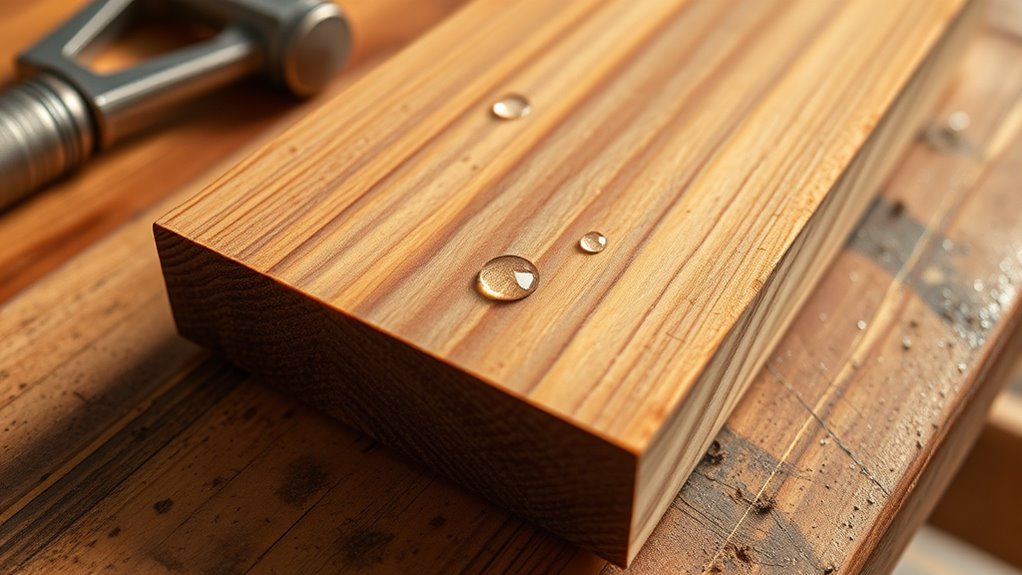The ideal wood moisture content depends on what you’re using the wood for and your environment. For indoor projects like furniture or cabinetry, aim for 6% to 8% moisture content to prevent issues like warping or cracking. For outdoor projects such as decks or siding, 12% to 15% is better to handle humidity changes. Monitoring moisture levels helps you achieve the right balance, and understanding these ranges will set your project up for success as you explore more details.
Key Takeaways
- Ideal moisture content varies: 6-8% for indoor use, 12-15% for outdoor projects.
- Proper moisture levels prevent warping, splitting, and decay over time.
- Moisture meters help monitor and maintain target moisture content throughout drying.
- Environmental factors like climate influence the ideal moisture range for different applications.
- Achieving the correct moisture content ensures wood stability, durability, and aesthetic quality.

Maintaining the correct moisture content in wood is essential to guarantee its stability, durability, and appearance. When you work with wood, understanding how to control its moisture level is key to ensuring your project turns out well. Proper wood drying is the process of reducing moisture content to the ideal range for your specific application. Too much moisture can cause the wood to warp, split, or rot over time, while too little can make it brittle and prone to cracking. To achieve this balance, you need to focus on accurate moisture measurement, which involves using tools like moisture meters to determine the wood’s current moisture level. These devices give you real-time data, allowing you to make informed decisions about when your wood is ready for use.
As you measure moisture, keep in mind that the ideal moisture content varies depending on the environment and the type of project. For indoor furniture or cabinetry, the moisture content typically should be between 6% and 8%. This range helps ensure the wood remains stable and won’t expand or contract excessively with humidity changes. For exterior projects like decks or siding, the ideal moisture level is usually a bit higher, around 12% to 15%, to accommodate outdoor conditions. When you understand the specific moisture requirements for your project, you can tailor your wood drying process accordingly. This might involve air drying, kiln drying, or a combination of both to reach the desired moisture content efficiently. Proper moisture control is also crucial to prevent long-term issues such as warping or decay.
Monitoring moisture measurement during the drying process is vital because it prevents over-drying or under-drying. If you dry wood too quickly, especially with high heat in kiln drying, you risk causing internal stresses that lead to cracking or warping. Conversely, if you don’t dry it enough, the excess moisture will cause problems down the line, especially in humid environments. Regularly checking the moisture levels with a reliable meter helps you stay on track and avoid these issues. Remember, the goal is to bring the wood to its ideal moisture content, which is the point where it’s most stable and best suited for its intended use. Additionally, regional climate conditions can influence the ideal moisture content for specific projects, as local environmental factors play a significant role in moisture control.
Frequently Asked Questions
How Does Humidity Affect Wood Moisture Content?
Humidity fluctuations directly impact your wood’s moisture content. When indoor climate has high humidity, your wood absorbs moisture and swells. Conversely, low humidity causes your wood to lose moisture, leading to shrinkage and potential cracking. You can manage this by controlling indoor humidity levels, especially during seasonal changes. Maintaining a stable environment helps keep your wood’s moisture content consistent, preventing damage and ensuring your woodworking projects stay durable and beautiful.
Can Moisture Meters Accurately Measure in All Wood Types?
You might think moisture meters are foolproof, but their calibration accuracy differs across different wood types. They can generally measure moisture well, but measurement limitations exist—like dense or exotic woods that can throw off readings. Always check if your meter’s calibrated for the specific wood you’re testing. Don’t rely solely on one reading; verify with multiple measurements to ensure you’re getting the most accurate results for your project.
What Are Signs of Over-Dried or Under-Dried Wood?
You’ll notice over-dried wood often shows excessive shrinkage, cracks, or gaps, making it unstable for projects. Under-dried wood may feel damp, emit a musty smell, or develop mold growth over time. Both conditions can compromise your work’s quality, so keep an eye out for signs of wood shrinkage or mold. Proper drying guarantees your wood remains stable, minimizes defects, and prevents issues linked to improper moisture levels.
How Long Does It Take for Wood to Reach Equilibrium Moisture Content?
Think of the drying process as a slow dance between wood and its environment; it can take anywhere from a few weeks to several months to attain moisture balance. Factors like wood type, thickness, and humidity levels influence this journey. During this time, moisture seeps out or into the wood, gradually balancing until equilibrium is achieved. Patience guarantees you get stable, well-dried wood ready for your project.
Does Wood Moisture Content Vary With Seasons?
Yes, wood moisture content varies with seasons due to seasonal fluctuations in humidity and temperature. During humid seasons, moisture levels increase, making the wood swell, while in dry seasons, moisture decreases, causing shrinkage. You’ll notice these moisture variations affect wood’s stability and performance, especially if you’re working on projects. To minimize issues, measure moisture content regularly and adapt your woodworking or construction practices to seasonal changes.
Conclusion
Knowing the ideal wood moisture content is like finding the perfect balance in a delicate dance. When you keep your wood properly conditioned, it’s like guiding a ship through calm waters—steady and secure. By maintaining the right moisture level, you make sure your projects last longer and stay true to their purpose. So, stay vigilant and treat your wood with care; it’s the foundation of craftsmanship that stands the test of time.











